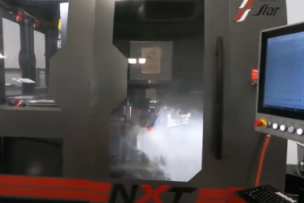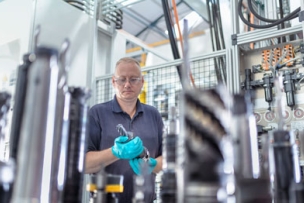Minimizing setup time by improving your workholding will keep your CNC machining operation running efficiently.
It may be time to give yourself a more accurate and repeatable grip with a better workholding chuck, top jaw or quick-change system. Here’s what you should know.
So you bought a new CNC lathe and want to get the most out of it? Or maybe you have an older machine and have never been happy with the length of your setup times? In either case, it may be time to take a look at your workholding.
The hydraulic chucks supplied with virtually all CNC lathes are a little like putting basic tires and rims on a sports car—they might get you around town, but if you want to go fast, you’d better upgrade.
So why should anyone purchase a new chuck when the one that’s on the machine seems to do a good job? There are many reasons, including less than stellar repeatability and runout along with an inability to clamp delicate parts. But the biggest reason is setup time: Even the fastest machinist needs about 10 minutes to change and rebore a set of top jaws. Plus, swapping a 3-jaw chuck for a 2-jaw or collet chuck might take half an hour, never mind the aching back afterward.
Here are some options to regain that lost setup time, and give yourself a more accurate and repeatable grip.
Quick-Change Top Jaws
Quick-change top jaws are a low-cost way to shave precious minutes off any machine changeover. Simply replace the standard T-nuts and bolts on a serrated-style hydraulic chuck with a set of carrier jaws, and then insert whatever support jaw, claw insert or machinable soft jaws are needed. One manufacturer claims jaw changes can be made in less than 15 seconds, with repeatability of 0.02 millimeter (0.0008 inch) or better.
Complete Quick-Change Systems
Several aftermarket chuck providers offer complete quick-change systems that boast three minutes or less to change out the chuck, allowing shops to easily switch between 3-jaw to 6-jaw to collet chuck to faceplate. Changeover is a matter of twisting a clamping mechanism to release the chuck. Some even allow existing chucks to be adapted to the quick-change system, reducing investment costs. Of course, they’re no less heavy than the stock chuck you’re replacing, so always use a hoist or cradle to support it during changeover.
The Value of Quick-Change Jaws
Even without a quick-change mount, many aftermarket chucks are equipped with a quick-change jaw mechanism, which is activated by rotating a locknut one-half turn to release the jaw and allow it to be slid into position. This approach is much more accurate than the serrated chuck jaws on your legacy chuck, and jaw reboring can often be avoided as a result.
Quick-Change Collet Chuck Systems
Collet chucks are the preferred way to hold most small parts and also for clamping smaller bar stock. Unfortunately, they take time to screw in and out of the adapter. And 5C and 16C collets often make it difficult to maintain accurate part length thanks to the “drawback” effect. A better approach is a quick-change collet system, which uses a special wrench to collapse the collet for easy removal and replacement. Most of these systems are also “dead-length,” eliminating any concerns over drawback.
The Value of Air Chucks
Air chucks are a great way to hold delicate or thin-walled parts. Pressures can be dialed down to just a few pounds if necessary, and changing top jaws is usually a matter of removing a half-dozen screws and popping the jaw off the locating pins. Though not truly “quick-change,” air chucks are an important tool for many secondary operations where great precision and a delicate touch are required.
Options: Hardened Top Jaws, Claw Jaws, Pie Jaws
Once you’ve equipped your machine with a quick-change workholding system, it’s time to look at top jaw options. For bar work on a hydraulic or collet chuck, hardened top jaws eliminate the need for boring and provide a secure grip. Simply slide them in or out to the required diameter and lock them in place. Claw jaws are a similar solution and should be used to grip castings, forgings or sawed blanks when cutting forces are high. Both tend to bite into the material, however, so should not be used on finished diameters. Also, the locating surface must be sufficiently oversize that the “bite marks” can be turned away when finishing the part.
Another option is pie jaws. As their name implies, these resemble a pie that’s been cut into three pieces. They provide more gripping area than regular jaws and are a good choice for large, thin-walled parts, oddly shaped castings or forgings, or orthogonal parts where a 2-jaw chuck is unavailable or impractical. Look for cast aluminum or cast-iron pie jaws for a hydraulic chuck and aluminum pie jaws for use with an air chuck.
Always adhere to the manufacturer’s recommended maintenance procedures, and never spin a chuck faster than its maximum rpm rating.
Always Follow Your Recommended Maintenance for Your Workholding System
Even the speediest of quick-change workholding systems will yield poor results if used improperly. Always adhere to the manufacturer’s recommended maintenance procedures, and never spin a chuck faster than its maximum rpm rating.
Clamping pressures should also be carefully monitored. As spindle speeds increase, centrifugal force tends to make most chucks open up, allowing the part to come loose if insufficient clamping pressure is used. In addition, hysteresis can cause clamping forces to skyrocket during sudden deceleration, possibly damaging the workpiece. Some manufacturers make chucks that are specially designed to prevent both of these conditions by maintaining consistent clamping at any rpm. Whichever way you go, take care of your chuck, and it will take care of you.
What kind of workholding setup does your shop use? Tell us.




Talk to Us!
Leave a reply
Your email address will not be published. Required fields are marked *